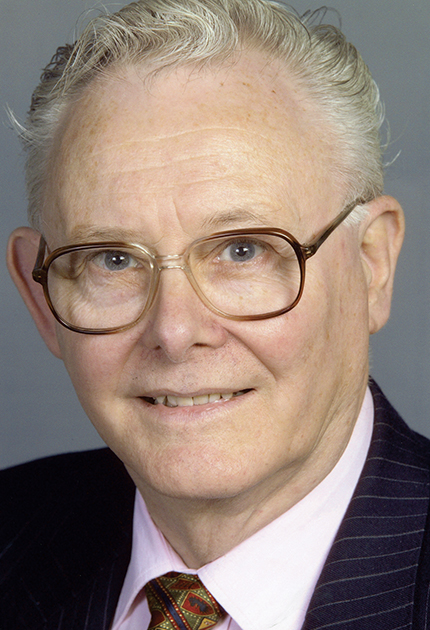Peter Mansfield
DOI: 10.1063/PT.3.3797
Peter Mansfield, who shared with Paul Lauterbur the 2003 Nobel Prize in Physiology or Medicine for the invention of magnetic resonance imaging (MRI), died on 8 February 2017 in Nottingham, UK.

Peter Mansfield
AIP ESVA, W. F. MEGGERS GALLERY OF NOBEL LAUREATES

The son of a gas fitter, Peter was born in South London on 9 October 1933. His education was disrupted by World War II, during which he was evacuated to Devon, where a kind family took him in. He was a late reader and was sent to a nonacademic secondary school. Playing with shrapnel on bomb sites, Peter developed an interest in science, but his careers teacher dismissed any idea of his working in science. He left school at age 15 and was taken on by a bookbinder, but with his typical drive, he spent three nights a week working toward his general certificate of education. After reading an article in the Daily Mirror about “a grammar school boy” who was working in the Ministry of Supply, he wrote to the editor, who suggested that he contact the ministry directly. That eventually led to a job in its rocket propulsion department in Buckinghamshire.
Peter continued in night school for his advanced-level certificate, and at 23 he was accepted at Queen Mary’s College in London to study physics. For his third-year project, he used the relatively new phenomenon of nuclear magnetic resonance (NMR) to measure Earth’s magnetic field. He was supervised by Jack Powles, who subsequently offered him a position to study for a PhD.
During his doctoral studies, Peter built a pulsed spectrometer with which he discovered the solid echo. After completing his PhD, he obtained a postdoctoral position with Charles Slichter at the University of Illinois at Urbana-Champaign and worked on NMR studies of doped metals. In 1964 Peter was appointed to a lectureship at the University of Nottingham. He remained there for the rest of his career, resisting many attempts to attract him elsewhere.
Those beginnings provided Peter with both the theoretical insight to understand how the NMR signal could encode spatial information and the experimental skills to realize that practically, and from 1972 Peter was absolutely focused on the problem. He read a paper by Ryogo Kubo describing an NMR signal in reciprocal space and recognized that the NMR equivalent of x-ray diffraction was possible. By 1973 he had demonstrated one-dimensional images of a sample composed of multiple sheets of camphor.
Meanwhile, Lauterbur conceived a method of imaging with NMR that used the principle of projection reconstruction, which he described in a seminal letter to Nature in 1973. The elegant simplicity of Lauterbur’s approach made the concept of NMR imaging immediately accessible.
Peter’s deep insight into the link between the acquired NMR signal and the object’s reciprocal space provided him with a powerful tool for manipulating the signals to produce images in new ways. Among his many contributions to NMR imaging, the most important are probably slice selection and echo planar imaging (EPI). Slice selection was initially controversial and required that special hardware be built; it took even more effort to convince the community of the value of EPI.
Peter conceived of EPI in 1977. Although he was first and foremost a physicist, he recognized the power of a technique that had sufficient speed to enable the study of dynamic processes in the body. He would click his fingers to illustrate that EPI could acquire an MR image in a “snapshot,” but it was initially infeasible given the hardware and computing power available at the time. But Peter knew what was possible and worked tirelessly for 15 years to make it a reality; in particular, he invented shielded gradient coils to enable rapid gradient switching. EPI started to become available on commercial scanners in the early 1990s, and it has since enabled more than 50 000 functional MRI studies of brain activation.
After retiring in 1994, Peter generously handed over large parts of his research program to colleagues, but he continued to work on the two key limitations of MRI: acoustic noise and the interactions of switched gradients with the human body.
Professionally, I remember Peter as completely focused and driven. He gave his full, undivided attention to each problem in turn. After talking about contrast-agent uptake curves for days, one night he produced a full mathematical model, explained it to me with his favorite electromagnetic analogy, and then moved on to the next challenge. He frequently told us to “pull ourselves up by our bootstraps,” and he encouraged us to share his independence and self-sufficiency.
Of course, Peter demanded perfection. Many people remember anxious moments, whether tuning the scanner to his exacting standards before the arrival of visiting dignitaries or printing images over and over until they displayed the exact contrast he required. Peter worked extremely hard, but he left time for deep concentration; the flash of inspiration in which he conceived EPI came while he waited at traffic lights on his way home for lunch.
Personally, I remember Peter as kind, considerate, and unpretentious, despite his ever-increasing fame and success. His spectacles were usually repaired with sticky tape, and in 25 years he never unpacked the boxes in his office. His wry smile in photos revealed the humor he found in everyday events. Peter ran third-year projects in Nottingham on human-powered flight and learned to fly helicopters at age 60. He had strong views on many world issues. He famously loved languages and arranged both Arabic and German lessons for his research group. Peter was interested in the lives of his staff and students, but first and foremost he was a family man; his wife often accompanied him to conferences, and he was close to his grandchildren. Known as PM by those who worked with him, Peter inspired their deep respect and affection.
More about the Authors
Penny Gowland. University of Nottingham, Nottingham, UK.
